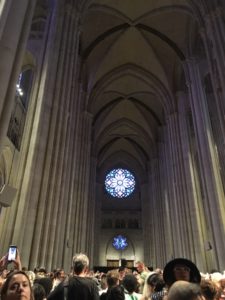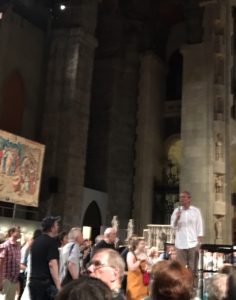
“If you see 600 singers coming towards you, get out of the way.”
That advice from conductor Simon Halsey was no doubt a first for most people at the truly-full-house audience at the Cathedral of St. John the Divine. But the Aug. 11 world premiere of the John Luther Adams choral work In the Name of the Earth was a singular occasion – 50 minutes of multiple choirs moving around the space while singing. Singing what? Nothing radical, but nothing so familiar either.
Nobody should’ve been disappointed that the original venue – the earth itself, and that corner of it known as Central Park in New York City – was rained out. I like the earth as much as anybody else, but for a Pulitzer-winning composer of Adams’s caliber, the contained environment of the cathedral was much more favorable to his ethereal, meticulously honed sounds. And In the Name of the Earth may stand among his best pieces.
This event was the second “earth piece” that week in Lincoln Center’s Mostly Mozart Festival, which still has plenty to do with Mozart but is also filling a bit of the void left by the now-gone Lincoln Center Festival by presenting cutting-edge events on the scale often seen across the river at the Brooklyn Academy of Music’s Next Wave Festival. Except that Mostly Mozart is now across the river as well, with the Aug. 6-8 run of The Force of Things: An Opera for Objects by composer Ashley Fure and her architect brother Adam Fure.
Both pieces were immersive: The audience was in the thick of the performing area, not a mass of detached spectators. Both trafficked in pure sound – electronically generated with Fure, often in frequencies too low for the human ear to hear but meant to stoke some climate-change anxiety in the marrow of your bones. Singers, often dressed in what resembled clear plastic rain ponchos, were present in the room – though they whispered, sometimes in megaphones and in a language that was meant to defy understanding.
Though Adams had singers intoning names of rivers, lakes, mountains and deserts in North America, their importance was as symbolic as literal. With 600 singers doing different things in different parts of the huge performing area, clear diction wasn’t going to be part of the playing field.
Both pieces had plenty of compositional ingenuity, but succeeded – or not – based on the visceral quality of the sound. In the opening seconds of In the Name of the Earth, you knew you were not only engulfed within a piece of considerable power, but in the midst of music that worked. Different choirs were intelligently placed in different parts of the cathedral. Several conductors were needed, as were what might be called performance aides, who held up giant cards with timings to show the vast contingent of singers (listed as 800 on various websites though Halsey’s number was 600) exactly where in the piece we all were – something necessary when the performers are covering such a large geographical area and the composer wants highly specific things to happen..
The sound events were best described as weather fronts. The first one had a harmonic world suggesting Ralph Vaughan Williams at his most lush, but with secondary harmonies that no composer in the first half of the 20th century would allow. Liberated Vaughan Williams? That description suggests that the music was spilling out from its container, but Adams’s writing still held a cogent shape that was extremely friendly to the ear but had no typical sense of musical narrative. Curiously absent was the poetic stasis sometimes heard from Kaija Saariaho. There was progression here – probably lying in a harmonic floor plan – though not a progression that felt typically symphonic. The music seemed to evolve, but not with a clearly etched beginning, middle and end. You couldn’t judge the piece by its length any more than you can tell a torrential rainstorm, “Time’s up!” Yet the music seemed to pursue specific, though subtle, goals. A later musical weather front was built from the bass voices on up, initially seeming to have Russian orthodox influence but similarly liberated.
The point, perhaps, is that In the Name of the Earth – like the earth it celebrates – isn’t on our timetable, not that of human beings and certainly not that of New Yorkers. This was intuitively composed music that had the outward trappings of civilization removed from it.

Sometimes when composers capture something primal that transcends civilized humanity, the results have a pictorial quality, as in The Rite of Spring, which conjures powerful images even if you don’t know the original ballet’s scenario. There was nothing pictorial about In The Name of the Earth. Adams isn’t above such descriptiveness, but here he seemed more interested in capturing his version of elemental sounds that seem to groan up from the center of the earth. The music seemed like sound that already existed; Adams just organized it. No irony. No anger. Near the end, singers all had tinkling objects that they rang and carried – from small single bells to jingle bells – and I’m happy to say that my only theory on what it meant was to bring listeners back to reality.
I was glad to see traditional musicians, such as Mostly Mozart music director Louis Langrée, there as spectators: It never hurts to be reminded of the most fundamental reasons why music exists.
In contrast, Ashley Fure’s opera for objects didn’t reach me at all. That’s a personal reaction rather than an aesthetic judgment. I had been excited enough by Fure’s Miller Theatre concert a few years back that I jumped at the chance to hear The Force of Things. I was happy to spend the hot late afternoon in the darkened Gelsey Kirkland Arts Center in the DUMBO neighborhood of Brooklyn: It was only minutes from my apartment, I saw lots of people I knew, and I loved the idea of hearing frequencies that I can’t hear. Fure explained the point: We can’t really feel the gradual deterioration of the planet, even in the face of cold hard statistics about rising sea levels and amid one of the hottest summers in recent history. The idea was to instill the kind of active concern we’d were this crucial issue confronting us directly in the face.
Much thought had gone into the contour of musical events and the blend of electronic sound and acoustic sound (however manipulated) made by vocalizing softly into a megaphone. But not only was I unmoved by the sound, but the architecture of the cistern-like space didn’t speak to me. Were it not for a pre-performance explanation, I would never have known that the piece was dealing with end-of-the-planet issues.
How would I envision the end of the planet? As a small child, I was convinced that I would wake up one day and discover that the sun had burned itself out. Dinosaurs would rise from their burial places and stomp all over our stuff. We would cower in our 1950s bomb shelters and get used to navigating the darkness. What does that say? That I’m wired for visual images. And maybe a composer such as Adams – who at age 65 can be safely called a highly evolved artist – is necessary to circumvent decades of conditioning and touch us at our core.

